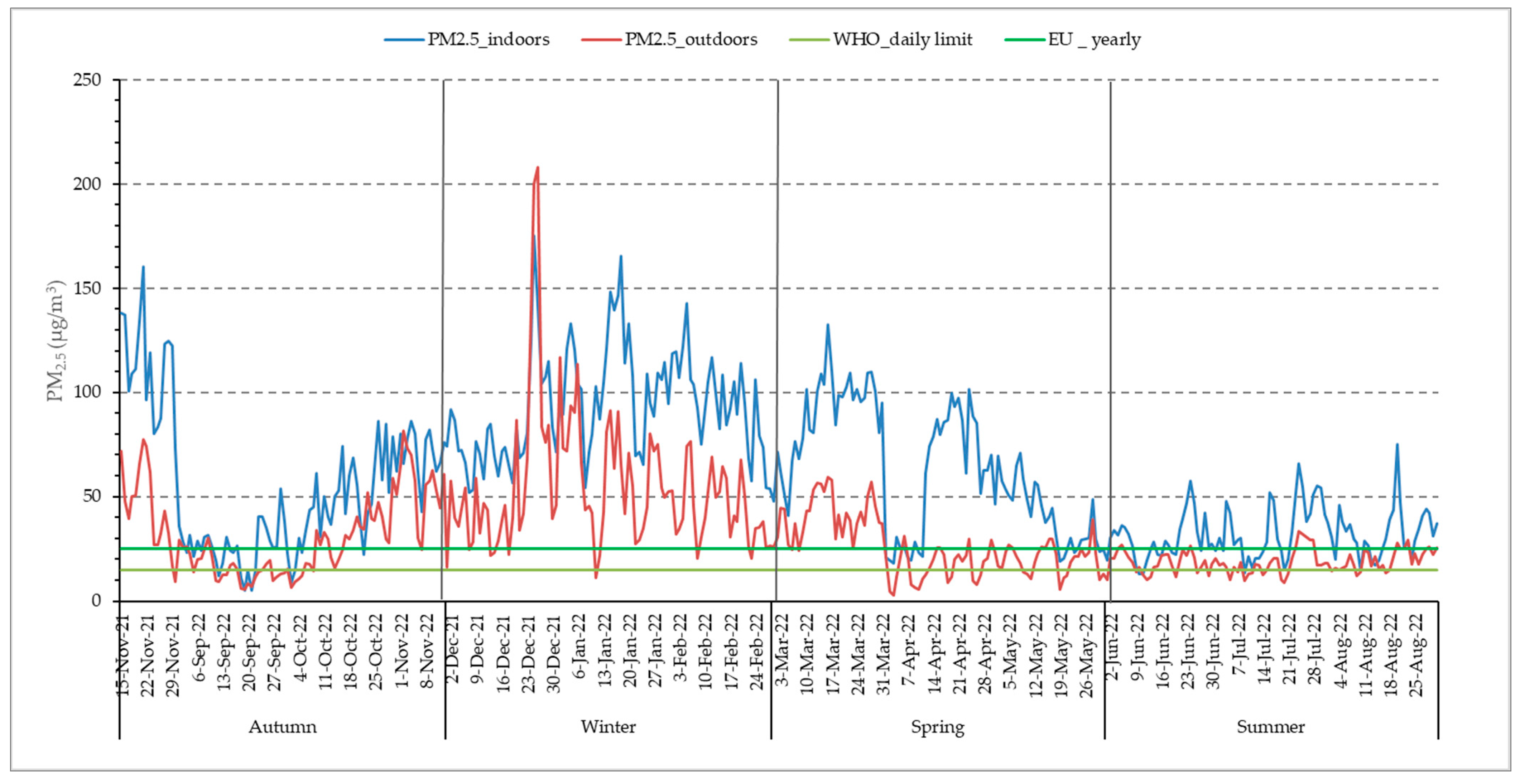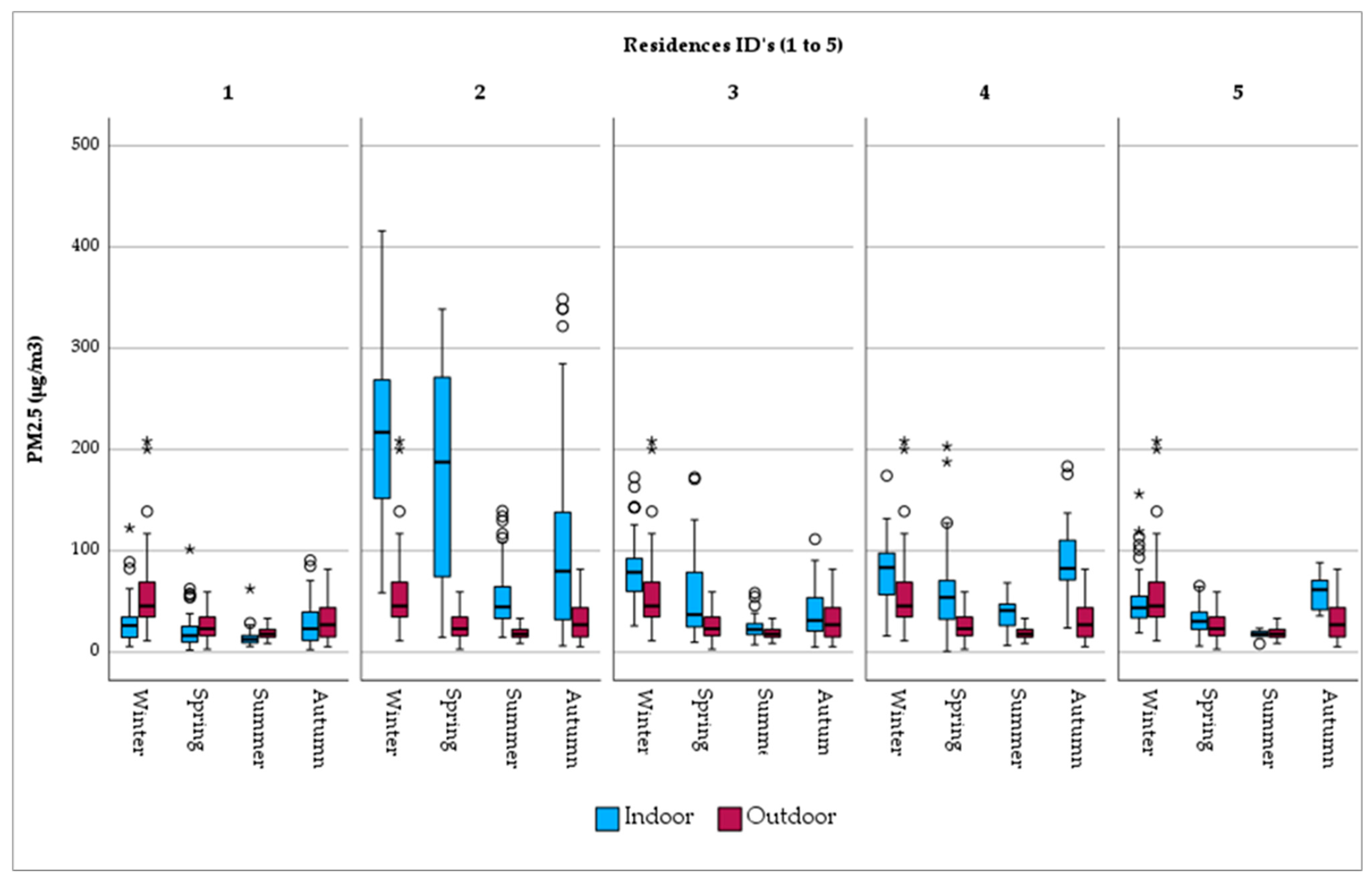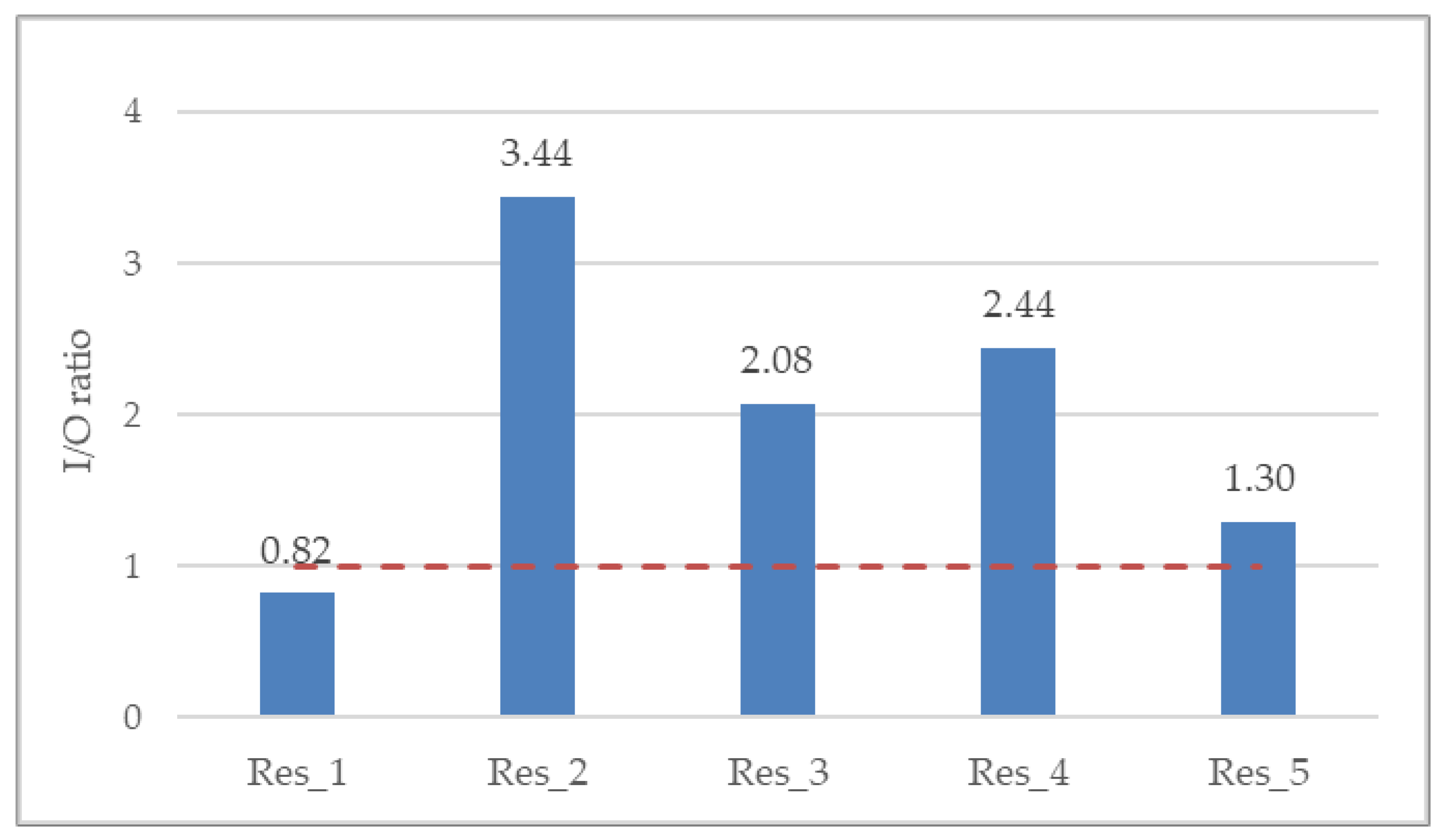Assessing the Impact of Spatial and Temporal Variability in Fine Particulate Matter Pollution on Respiratory Health Outcomes in Asthma and COPD Patients
Abstract
:1. Introduction
2. Materials and Methods
2.1. Study Design
2.2. Participants Recruitment and Residence Characteristics
2.3. Respiratory Health
2.4. PM2.5 and Meteorological Factors Monitoring
2.5. Statistical Analysis
3. Results
3.1. Data Collection—PM2.5 Exposure
3.2. PM2.5 Impact on Pulmonary Function
4. Discussion
5. Conclusions
Author Contributions
Funding
Institutional Review Board Statement
Informed Consent Statement
Data Availability Statement
Conflicts of Interest
References
- Urbanization. Available online: https://ourworldindata.org/urbanization (accessed on 18 December 2023).
- Sousa, A.C.; Pastorinho, M.R.; Masjedi, M.R.; Urrutia-Pereira, M.; Arrais, M.; Nunes, E.; To, T.; Ferreira, A.J.; Robalo-Cordeiro, C.; Borrego, C.; et al. Issue 1-Update on adverse respiratory effects of outdoor air pollution (Part 2): Outdoor air pollution and respiratory diseases: Perspectives from Angola, Brazil, Canada, Iran, Mozambique and Portugal. Pulmonology 2022, 28, 376–395. [Google Scholar] [CrossRef] [PubMed]
- Mohan, A.; Alupo, P.; Martinez, F.J.; Mendes, R.G.; Zhang, J.; Hurst, J.R. Respiratory Health and Cities. Am. J. Respir. Crit. Care Med. 2023, 208, 371–373. [Google Scholar] [CrossRef] [PubMed]
- WHO Global Air Quality Guidelines: Particulate Matter (PM2.5 and PM10), Ozone, Nitrogen Dioxide, Sulfur Dioxide and Carbon Monoxide. Available online: https://iris.who.int/handle/10665/34539 (accessed on 18 February 2024).
- Brunekreef, B.; Strak, M.; Chen, J.; Andersen, Z.J.; Atkinson, R.; Bauwelinck, M.; Bellander, T.; Boutron, M.C.; Brandt, J.; Carey, I.; et al. Mortality and Morbidity Effects of Long-Term Exposure to Low-Level PM2.5, BC, NO2, and O3: An Analysis of European Cohorts in the ELAPSE Project. Res. Rep. (Health Eff. Inst.) 2021, 208, 1–127. [Google Scholar]
- Dominski, F.H.; Lorenzetti Branco, J.H.; Buonanno, G.; Stabile, L.; Gameiro da Silva, M.; Andrade, A. Effects of air pollution on health: A mapping review of systematic reviews and meta-analyses. Environ. Res. 2021, 201, 111487. [Google Scholar] [CrossRef] [PubMed]
- USA Environmental Protection Agency. Particulate Matter (PM) Pollution. Available online: https://www.epa.gov/pm-pollution/particulate-matter-pm-basics (accessed on 29 November 2023).
- Mukherjee, A.; Agrawal, M. A Global Perspective of Fine Particulate Matter Pollution and Its Health Effects. Rev. Environ. Contam. Toxicol. 2018, 244, 5–51. [Google Scholar] [CrossRef] [PubMed]
- Stafoggia, M.; Oftedal, B.; Chen, J.; Rodopoulou, S.; Renzi, M.; Atkinson, R.W.; Bauwelinck, M.; Klompmaker, J.O.; Mehta, A.; Vienneau, D.; et al. Long-term exposure to low ambient air pollution concentrations and mortality among 28 million people: Results from seven large European cohorts within the ELAPSE project. Lancet 2022, 6, 9–18. [Google Scholar] [CrossRef] [PubMed]
- Masselot, P.; Sera, F.; Schneider, R.; Kan, H.; Lavigne, É.; Stafoggia, M.; Tobias, A.; Chen, H.; Burnett, R.T.; Schwartz, J.; et al. Differential mortality risks associated with PM2.5 components: A multi-country, multi-city study. Epidemiology 2022, 33, 167–175. [Google Scholar] [CrossRef] [PubMed]
- Jiang, X.Q.; Mei, X.D.; Feng, D. Air pollution and chronic airway diseases: What should people know and do? J. Thorac. Dis. 2016, 8, E31–E40. [Google Scholar] [CrossRef]
- Mermiri, M.; Mavrovounis, G.; Kanellopoulos, N.; Papageorgiou, K.; Spanos, M.; Kalantzis, G.; Saharidis, G.; Gourgoulianis, K.; Pantazopoulos, I. Effect of PM2.5 Levels on ED Visits for Respiratory Causes in a Greek Semi-Urban Area. J. Pers. Med. 2022, 12, 1849. [Google Scholar] [CrossRef] [PubMed]
- Wang, M.; Aaron, C.P.; Madrigano, J.; Hoffman, E.A.; Angelini, E.; Yang, J.; Laine, A.; Vetterli, T.M.; Kinney, P.L.; Sampson, P.D.; et al. Association Between Long-term Exposure to Ambient Air Pollution and Change in Quantitatively Assessed Emphysema and Lung Function. JAMA 2019, 322, 546–556. [Google Scholar] [CrossRef]
- Paulin, L.; Hansel, N. Particulate air pollution and impaired lung function. F1000Research 2016, 5, 7108.1. [Google Scholar] [CrossRef] [PubMed]
- Elbarbary, M.; Oganesyan, A.; Honda, T.; Kelly, P.; Zhang, Y.; Guo, Y.; Morgan, G.; Guo, Y.; Negin, J. Ambient air pollution, lung function and COPD: Cross-sectional analysis from the WHO Study of AGEing and adult health wave 1. BMJ 2020, 7, e000684. [Google Scholar] [CrossRef] [PubMed]
- Ścibor, M.; Balcerzak, B.; Galbarczyk, A.; Jasienska, G. Associations between Daily Ambient Air Pollution and Pulmonary Function, Asthma Symptom Occurrence, and Quick-Relief Inhaler Use among Asthma Patients. Int. J. Environ. Res. Public Health 2022, 19, 4852. [Google Scholar] [CrossRef] [PubMed]
- Hulin, M.; Simoni, M.; Viegi, G.; Annesi-Maesano, I. Respiratory health and indoor air pollutants based on quantitative exposure assessments. Eur. Respir. J. 2012, 40, 1033–1045. [Google Scholar] [CrossRef] [PubMed]
- Brasche, S.; Bischof, W. Daily time spent indoors in German homes–Baseline data for the assessment of indoor exposure of German occupants. Int. J. Hyg. Environ. Health 2005, 208, 247–253. [Google Scholar] [CrossRef] [PubMed]
- Wang, J.; Du, W.; Lei, Y.; Chen, Y.; Wang, Z.; Mao, K.; Tao, S.; Pan, B. Quantifying the dynamic characteristics of indoor air pollution using real-time sensors: Current status and future implication. Environ. Int. 2023, 175, 107934. [Google Scholar] [CrossRef] [PubMed]
- Hart, J.E.; Grady, S.T.; Laden, F.; Coull, B.A.; Koutrakis, P.; Schwartz, J.D.; Moy, M.L.; Garshick, E. Effects of Indoor and Ambient Black Carbon and PM2.5 on Pulmonary Function among Individuals with COPD. Environ. Health Perspect. 2018, 126, 127008. [Google Scholar] [CrossRef] [PubMed]
- de Hartog, J.J.; Ayres, J.G.; Karakatsani, A.; Analitis, A.; Brink, H.T.; Hameri, K.; Harrison, R.; Katsouyanni, K.; Kotronarou, A.; Kavouras, I.; et al. Lung function and indicators of exposure to indoor and outdoor particulate matter among asthma and COPD patients. Occup. Environ. Med. 2010, 67, 2–10. [Google Scholar] [CrossRef]
- Hsu, S.O.; Ito, K.; Lippmann, M. Effects of thoracic and fine PM and their components on heart rate and pulmonary function in COPD patients. J. Expo. Sci. Environ. Epidemiol. 2011, 21, 464–472. [Google Scholar] [CrossRef]
- Cortez-Lugo, M.; Ramírez-Aguilar, M.; Pérez-Padilla, R.; Sansores-Martínez, R.; Ramírez-Venegas, A.; Barraza-Villarreal, A. Effect of Personal Exposure to PM2.5 on Respiratory Health in a Mexican Panel of Patients with COPD. Int. J. Environ. Res. Public. Health 2015, 12, 10635–10647. [Google Scholar] [CrossRef]
- Evangelopoulos, D.; Chatzidiakou, L.; Walton, H.; Katsouyanni, K.; Kelly, F.J.; Quint, J.K.; Jones, R.L.; Barratt, B. Personal exposure to air pollution and respiratory health of COPD patients in London. Eur. Respir. J. 2021, 58, 2003432. [Google Scholar] [CrossRef]
- Paterson, C.A.; Sharpe, R.A.; Taylor, T.; Morrissey, K. Indoor PM2.5, VOCs and asthma outcomes: A systematic review in adults and their home environments. Environ. Res. 2021, 202, 111631. [Google Scholar] [CrossRef]
- European Committee for Standardization (CEN). EN 14907:2005; Ambient Air Quality—Standard Gravimetric Measurement Method for the Determination of the PM2.5 Mass Fraction of Suspended Particulate Matter. CEN: Brussels, Belgium, 2005. Available online: http://disq.us/t/3owz237 (accessed on 20 November 2023).
- World Health Organization. WHO Guidelines for Indoor Air Quality: Selected Pollutants. Available online: http://www.euro.who.int/_data/assets/pdf_file/0009/128169/e94535.pdf (accessed on 20 November 2023).
- Vardoulakis, S.; Giagloglou, E.; Steinle, S.; Davis, A.; Sleeuwenhoek, A.; Galea, K.S.; Dixon, K.; Crawford, J.O. Indoor Exposure to Selected Air Pollutants in the Home Environment: A Systematic Review. Int. J. Environ. Res. Public Health 2020, 17, 8972. [Google Scholar] [CrossRef]
- Zhao, D.; Chen, H.; Yu, E.; Luo, T. PM2.5/PM10 Ratios in Eight Economic Regions and Their Relationship with Meteorology in China. Adv. Meteorol. 2019, 2019, 5295726. [Google Scholar] [CrossRef]
- Fameli, K.-M.; Dionysis, K.; Assimakopoulos, V. Seasonal Changes on PM2.5 Concentrations and Emissions at Urban Hotspots in the Greater Athens Area, Greece. Environ. Sci. Proc. 2023, 26, 124. [Google Scholar] [CrossRef]
- Yang, Q.; Yuan, Q.; Li, T.; Shen, H.; Zhang, L. The Relationships between PM2.5 and Meteorological Factors in China: Seasonal and Regional Variations. Int. J. Environ. Res. Public Health 2017, 14, 1510. [Google Scholar] [CrossRef] [PubMed]
- Ziernicka-Wojtaszek, A.; Zuśka, Z.; Kopcińska, J. Assessment of the Effect of Meteorological Conditions on the Concentration of Suspended PM2.5 Particulate Matter in Central Europe. Sustainability 2024, 16, 4797. [Google Scholar] [CrossRef]
- Koçak, E.; Balcılar, İ. Spatio-temporal variation of particulate matter with health impact assessment and long-range transport-case study: Ankara, Türkiye. Sci. Total Environ. 2024, 938, 173650. [Google Scholar] [CrossRef] [PubMed]
- Ward, T.; Palmer, C.; Bergauff, M.; Hooper, K.; Noonan, C. Results of a residential indoor PM2.5 sampling program before and after a woodstove changeout. Indoor Air 2008, 18, 408–415. [Google Scholar] [CrossRef]
- Gurley, E.S.; Salje, H.; Homaira, N.; Ram, P.K.; Haque, R.; Petri, W.A., Jr.; Bresee, J.; Moss, W.J.; Luby, S.P.; Breysse, P.; et al. Seasonal concentrations and determinants of indoor particulate matter in a low-income community in Dhaka, Bangladesh. Environ. Res. 2013, 121, 11–16. [Google Scholar] [CrossRef]
- Wyss, A.B.; Jones, A.C.; Bølling, A.K.; Kissling, G.E.; Chartier, R.; Dahlman, H.J.; Rodes, C.E.; Archer, J.; Thornburg, J.; Schwarze, P.E.; et al. Particulate Matter 2.5 Exposure and Self-Reported Use of Wood Stoves and Other Indoor Combustion Sources in Urban Nonsmoking Homes in Norway. PLoS ONE 2016, 11, e0166440. [Google Scholar] [CrossRef] [PubMed]
- Raaschou-Nielsen, O.; Sørensen, M.; Hertel, O.; Chawes, B.L.; Vissing, N.; Bønnelykke, K.; Bisgaard, H. Predictors of indoor fine particulate matter in infants’ bedrooms in Denmark. Environ. Res. 2011, 111, 87–93. [Google Scholar] [CrossRef] [PubMed]
- Nasir, Z.A.; Colbeck, I. Particulate pollution in different housing types in a UK suburban location. Sci. Total Environ. 2013, 445–446, 165–176. [Google Scholar] [CrossRef] [PubMed]
- Jones, N.C.; Thornton, C.A.; Mark, D.; Harrison, R.M. Indoor/outdoor relationships of particulate matter in domestic homes with roadside, urban and rural locations. Atmos. Environ. 2000, 34, 2603–2612. [Google Scholar] [CrossRef]
- Zhao, J.; Birmili, W.; Wehner, B.; Daniels, A.; Weinhold, K.; Wang, L.; Merkel, M.; Kecorius, S.; Tuch, T.; Franck, U.; et al. Particle Mass Concentrations and Number Size Distributions in 40 Homes in Germany: Indoor-to-outdoor Relationships, Diurnal and Seasonal Variation. Aerosol Air Qual. 2020, 20, 576–589. [Google Scholar] [CrossRef]
- Chen, X.C.; Chuang, H.C.; Ward, T.J.; Tian, L.; Cao, J.J.; Ho, S.S.; Lau, N.C.; Hsiao, T.C.; Yim, S.H.; Ho, K.F. Indoor, outdoor, and personal exposure to PM2.5 and their bioreactivity among healthy residents of Hong Kong. Environ. Res. 2020, 188, 109780. [Google Scholar] [CrossRef] [PubMed]
- Carr, T.F.; Bleecker, E. Asthma heterogeneity and severity. World Allergy Organ. J. 2016, 9, 41. [Google Scholar] [CrossRef] [PubMed]
- Fong, W.C.G.; Kadalayil, L.; Lowther, S.; Grevatt, S.; Potter, S.; Tidbury, T.; Bennett, K.; Larsson, M.; Nicolas, F.; Kurukulaaratchy, R.; et al. The efficacy of the Dyson air purifier on asthma control: A single-center, investigator-led, randomized, double-blin d, placebo-controlled trial. Ann. Allergy Asthma Immunol. 2023, 130, 199–205. [Google Scholar] [CrossRef]
- Ścibor, M.; Galbarczyk, A.; Jasienska, G. Living Well with Pollution? The Impact of the Concentration of PM2.5 on the Quality of Life of Patients with Asthma. Int. J. Environ. Res. Public Health 2019, 16, 2502. [Google Scholar] [CrossRef]




| Sampling Site | Asthma/COPD | Disease Severity | No of Residents | Floor/ Surface Area (m2) | Sampling Room Surface Area (m2) | Pets | Smoking Status | Household Activities with PM2.5 Generation | Cooker Type and Cooking Duration | Heating/Cooling System |
|---|---|---|---|---|---|---|---|---|---|---|
| Res_1 | Asthma | GINA step 5 | 2 | 3rd 52 | 35 | No | Never smoker | Cooking, candles, incense | Electric cooker <30 min | Natural gas/ air conditioning and Fan |
| Res_2 | Asthma | GINA step 5 | 3 | 4th 110 | 60 | No | Current smoker | cooking, smoking, fireplace use | Electric cooker 30–60 min | Oil central heating and fireplace/ air conditioning |
| Res_3 | COPD | GOLD 2 | 3 | 1st 100 | 50 | Yes | Current smoker | Cooking, smoking | Electric cooker 60–120 min | Oil central heating/ air conditioning |
| Res_4 | Asthma | GINA step 5 | 2 | Ground floor 65 | 20 | No | Current smoker | Cooking, smoking | Electric cooker 60–120 min | Natural gas/ air conditioning and fan |
| Res_5 | Asthma | GINA step 5 | 4 | 7th 130 | 40 | Yes | Never smoker | Cooking, vaping | Electric cooker <120 min | Natural gas/ air conditioning |
| Overall | Winter | Spring | Summer | Autumn | |
|---|---|---|---|---|---|
| Outdoor, n (%) | 1337 (73.3%) | 385 (85.6%) | 380 (82.6%) | 259 (56.3%) | 313 (68.8%) |
| PM2.5 (μg/m3) | |||||
| Mean (±SD) | 33.88 (±24.03) | 51.52 (±29.59) | 26.86 (±14.80) | 18.77 (±6.61) | 33.19 (±21.43) |
| Median (IQR) | 27.14 (26.64) | 44.42 (32.02) | 23.96 (19.37) | 18.22 (8.98) | 28.89 (33.45) |
| Temperature (°C) | |||||
| Mean (±SD) | 18 (±6) | 12 (±2) | 17 (±5) | 29 (±3) | 20 (4) |
| Median (IQR) | 17 (12) | 12 (3) | 17 (8) | 29 (4) | 20 (7) |
| Relative Humidity (%) | |||||
| Mean (±SD) | 45 (11) | 49 (11) | 44 (8) | 39 (±9) | 48 (1 ± 2) |
| Median (IQR) | 45 (15) | 48 (16) | 44 (12) | 38 (15) | 48 (18) |
| Indoor, n (%) | 1457 (79.8%) | 397 (88.2%) | 449 (97.6%) | 303 (65.9%) | 308 (67.7%) |
| PM2.5 (μg/m3) | |||||
| Mean (±SD) | 63.89 (±68.41) | 91.63 (±81.19) | 64.11 (±72.31) | 31.71 (±23.89) | 59.50 (±58.86) |
| Median (IQR) | 40.09 (54.61) | 63.73 (80.96) | 36.59 (50.20) | 25.15 (26.57) | 41.67 (52.29) |
| Temperature (°C) | |||||
| Mean (±SD) | 24 (±3) | 22 (±2) | 23 (±2) | 29 (±2) | 24 (±3) |
| Median (IQR) | 24 (6) | 22 (3) | 23 (4) | 29 (3) | 23 (6) |
| Relative Humidity (%) | |||||
| Mean (±SD) | 46 (±8) | 44 (±7) | 46 (±7) | 44 (±7) | 53 (±10) |
| Median (IQR) | 46 (12) | 44 (10) | 46 (10) | 42 (9) | 53 (17) |
| I/O ratio | |||||
| Mean (±SD) | 2.20 (±2.10) | 2.00 (±1.92) | 2.82 (±2.73) | 1.70 (±1.03) | 1.94 (±1.62) |
| Median (IQR) | 1.47 (1.81) | 1.22 (1.95) | 1.80 (2.40) | 1.41 (1.46) | 1.40 (1.53) |
| Hours indoors (%) | 14.1 (58%) | 17.8 (75%) | 13.3 (54%) | 11.6 (48%) | 13.9 (58%) |
| Yearly | Winter | Spring | Summer | Autumn | |
|---|---|---|---|---|---|
| Estimated change (95% CI) p-value | Estimated change (95% CI) p-value | Estimated change (95% CI) p-value | Estimated change (95% CI) p-value | Estimated change (95% CI) p-value | |
| Home Outdoor | |||||
| lag 0 | −5.133 (−10.222, −0.043) 0.048 * | −7.508 (−17.556, 2.539) 0.142 | −1.264 (−10.285, 0.757) 0.782 | 24.906 (3.751, 6.061) 0.021 * | −7.531 (−18.078, 3.016) 0.160 |
| lag 1 | −6.407 (−11.369,−1.445) 0.011 * | −6.000 (−15.239, 3.238) 0.201 | 0.791 (−8.024, 9.607) 0.859 | 17.341 (−3.503, 38.186) 0.102 | −14.342 (−24.809, −3.875) 0.007 * |
| lag 2 | −5.874 (−10.913, −0.836) 0.022 * | −7.367 (−16.578, 1.845) (0.116) | 2.723 (−6.041, 11.488) (0.540) | 23.329 (4.467, 42.191) 0.016 * | −11.923 (−23.827, −0.019) 0.050 * |
| lag 3 | −6.182 (−11.140, −1.224) 0.015 * | −7.487 (−16.761, 1.787) 0.113 | 1.636 (−7.031, 10.304) 0.710 | 21.338 (1.392, 41.284) 0.036 * | −11.718 (−22.408, −1.028) 0.032 * |
| Home Indoor | |||||
| lag 0 | −1.902 (−6.625, 2.821) 0.429 | 2.146 (−10.116, 14.407) 0.731 | −5.743 (−12.963, 1.476) 0.119 | −4.891 (−17.542, 7.760) 0.447 | −18.812 (−29.907, −7.717) <0.001 ** |
| lag 1 | 7.975 (2.571, 13.379) 0.004 * | 2.781 (−9.356, 14.919) 0.652 | 0.974 (−5.906, 7.854) 0.781 | −6.793 (−19.677, 6.091) 0.300 | −25.151 (−36.029, −14.274) <0.001 ** |
| lag 2 | 9.960 (4.647, 15.274) <0.001 ** | −1.585 (−13.848, 10.679) 0.799 | 1.309 (−5.631, 8.249) 0.711 | −3.092 (−16.160, 9.976) 0.641 | −17.615 (−28.510, −6.720) 0.002 * |
| lag 3 | 10.584 (5.165, 16.003) <0.001 ** | −3.905 (−15.990, 8.180) 0.525 | 1.168 (−5.838, 8.174) 0.743 | −0.128 (−13.593, 13.337) 0.985 | −13.566 (−25.276, −1.855) 0.023 * |
| Symptoms | Odds Ratio | 95% CI | p-Value |
|---|---|---|---|
| Indoor | |||
| Cough | 0.996 | (0.992, 1.001) | 0.115 |
| Breathlesness | 0.963 | (0.941, 0.986) | 0.002 * |
| Wheezing | 1.004 | (1.000, 1.009) | 0.048 * |
| Ambient | |||
| Cough | 0.990 | (0.966, 1.014) | 0.402 |
| Breathlessness | 0.968 | (0.935, 1.002) | 0.063 |
| Wheezing | 1.004 | (0.996, 1.012) | 0.325 |
| Questionnaires | Estimated Change | 95% CI | p-Value |
|---|---|---|---|
| Indoor | |||
| AQLQ | 0.038 | (−0.064, 0.140) | 0.456 |
| ACT | 0.003 | (−0.007, 0.013) | 0.564 |
| Ambient | |||
| AQLQ | 0.148 | (−0.144, 0.440) | 0.313 |
| ACT | 0.016 | (−0.012, 0.044) | 0.259 |
Disclaimer/Publisher’s Note: The statements, opinions and data contained in all publications are solely those of the individual author(s) and contributor(s) and not of MDPI and/or the editor(s). MDPI and/or the editor(s) disclaim responsibility for any injury to people or property resulting from any ideas, methods, instructions or products referred to in the content. |
© 2024 by the authors. Licensee MDPI, Basel, Switzerland. This article is an open access article distributed under the terms and conditions of the Creative Commons Attribution (CC BY) license (https://creativecommons.org/licenses/by/4.0/).
Share and Cite
Xydi, I.; Saharidis, G.; Kalantzis, G.; Pantazopoulos, I.; Gourgoulianis, K.I.; Kotsiou, O.S. Assessing the Impact of Spatial and Temporal Variability in Fine Particulate Matter Pollution on Respiratory Health Outcomes in Asthma and COPD Patients. J. Pers. Med. 2024, 14, 833. https://doi.org/10.3390/jpm14080833
Xydi I, Saharidis G, Kalantzis G, Pantazopoulos I, Gourgoulianis KI, Kotsiou OS. Assessing the Impact of Spatial and Temporal Variability in Fine Particulate Matter Pollution on Respiratory Health Outcomes in Asthma and COPD Patients. Journal of Personalized Medicine. 2024; 14(8):833. https://doi.org/10.3390/jpm14080833
Chicago/Turabian StyleXydi, Irini, Georgios Saharidis, Georgios Kalantzis, Ioannis Pantazopoulos, Konstantinos I. Gourgoulianis, and Ourania S. Kotsiou. 2024. "Assessing the Impact of Spatial and Temporal Variability in Fine Particulate Matter Pollution on Respiratory Health Outcomes in Asthma and COPD Patients" Journal of Personalized Medicine 14, no. 8: 833. https://doi.org/10.3390/jpm14080833







